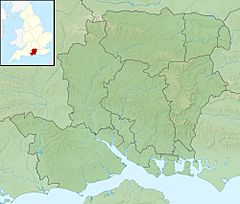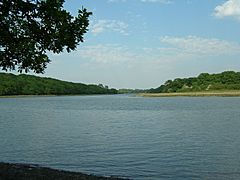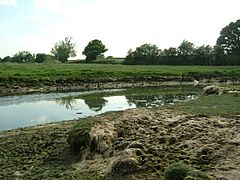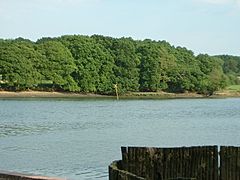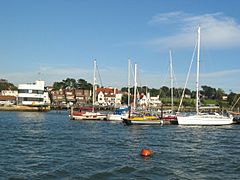River Hamble facts for kids
Quick facts for kids River Hamble |
|
|---|---|
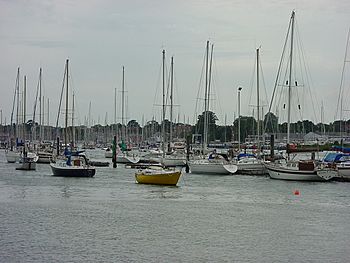
Yachts on the Hamble
|
|
| Country | England |
| County | Hampshire |
| Settlements | Bishops Waltham, Botley, Bursledon, Hamble, Warsash |
| Physical characteristics | |
| Main source | Bishops Waltham, Hampshire. 50°57′15″N 1°12′56″W / 50.954295°N 1.215497°W |
| River mouth | Southampton Water 50°50′30″N 1°18′45″W / 50.841601°N 1.312546°W |
| Length | 10.1 km (6.3 mi) |
The River Hamble is a cool river in southern Hampshire, England. It starts near Bishop's Waltham and flows for about 10 kilometers (6 miles). Along its journey, it passes through towns like Botley, Bursledon, and Lower Swanwick. Finally, it joins Southampton Water between Hamble Common and Warsash.
About half of the Hamble's length is affected by the ocean's tides. This means the water level goes up and down with the sea. The river is also "navigable" below Botley, which means boats can travel on it. For hundreds of years, from medieval times until now, the Hamble has been a super important place for building ships and boats. Even today, people still build boats for fun on the Hamble! One famous boat builder was Luke & Co, which later became Luke Bros. They were well-known from around 1890 until they closed in 1945. The lower part of the river is a popular spot for yachting because it's easy to get to the calm waters of Southampton Water and the Solent.
Where the River Hamble Flows
From where it starts to where it meets the sea, the River Hamble makes a curvy path, mostly heading southwest. It picks up smaller streams along the way before reaching Botley. Botley is home to a very old watermill.
After Botley, the river becomes tidal, meaning the sea's tides affect its water level. It also becomes wide enough for boats to travel on it. More streams join the river from nearby areas like Hedge End, Curdridge, Shedfield, and Burridge.
This part of the river was used a lot for building ships way back in the Middle Ages. The wood for these ships came from the local forests. Places like Kings Copse, which used to be part of a bigger forest called Kings Forest, remind us of this important history.
You can visit the west bank of the river at Manor Farm Country Park. Here, you can walk through lovely woods like Dock Copse and Fosters Copse. If the tide is very low, you might even see the remains of a famous 15th-century warship called the Grace Dieu. During World War II, this part of the river was also home to HMS Cricket. This was a special training base for Royal Marines learning to use landing craft.
About 3 kilometers (2 miles) south of Botley, the river flows between the villages of Bursledon and Lower Swanwick. Here, big bridges carry the M27 motorway, the railway line from Portsmouth to Southampton, and the A27 road over the river. Another 3 kilometers (2 miles) south of Bursledon, the river passes between Hamble-le-Rice and Warsash before flowing into Southampton Water.
A small passenger ferry crosses the river between Hamble-le-Rice and Warsash. This ferry is a handy link for people walking along the Solent Way and the E9 European Coastal Path. This part of the river is full of marinas, which are like parking lots for boats. The Port Hamble Marina is one of the biggest. There are also many boat yards on both sides of the river, all the way up to Bursledon. On the east side, south of Warsash, you'll find the Warsash Maritime School. This school, part of Solent University, trains people to work on merchant ships.
River Health: Water Quality
The Environment Agency checks the water quality of rivers in England. They give each river a score for its overall health, which can be high, good, moderate, poor, or bad. They look at different things to decide this. For example, they check the types and numbers of tiny creatures (like invertebrates), plants, and fish living in the water. They also test for chemicals to make sure they are not at harmful levels.
In the 1970s and 80s, many yachts using the river caused pollution. They used special paints on their hulls to stop barnacles from growing, but these paints contained a chemical called tributyltin. This chemical leaked into the water and caused problems. By 1988, the River Hamble had the highest known level of this chemical in the UK!
Luckily, the use of this harmful paint was banned for smaller boats (under 25 meters long). After the ban, the amount of tributyltin in the river's tidal waters dropped a lot. Now, the levels are considered harmless, which is great news for the river's health and the creatures living in it!
Gallery


